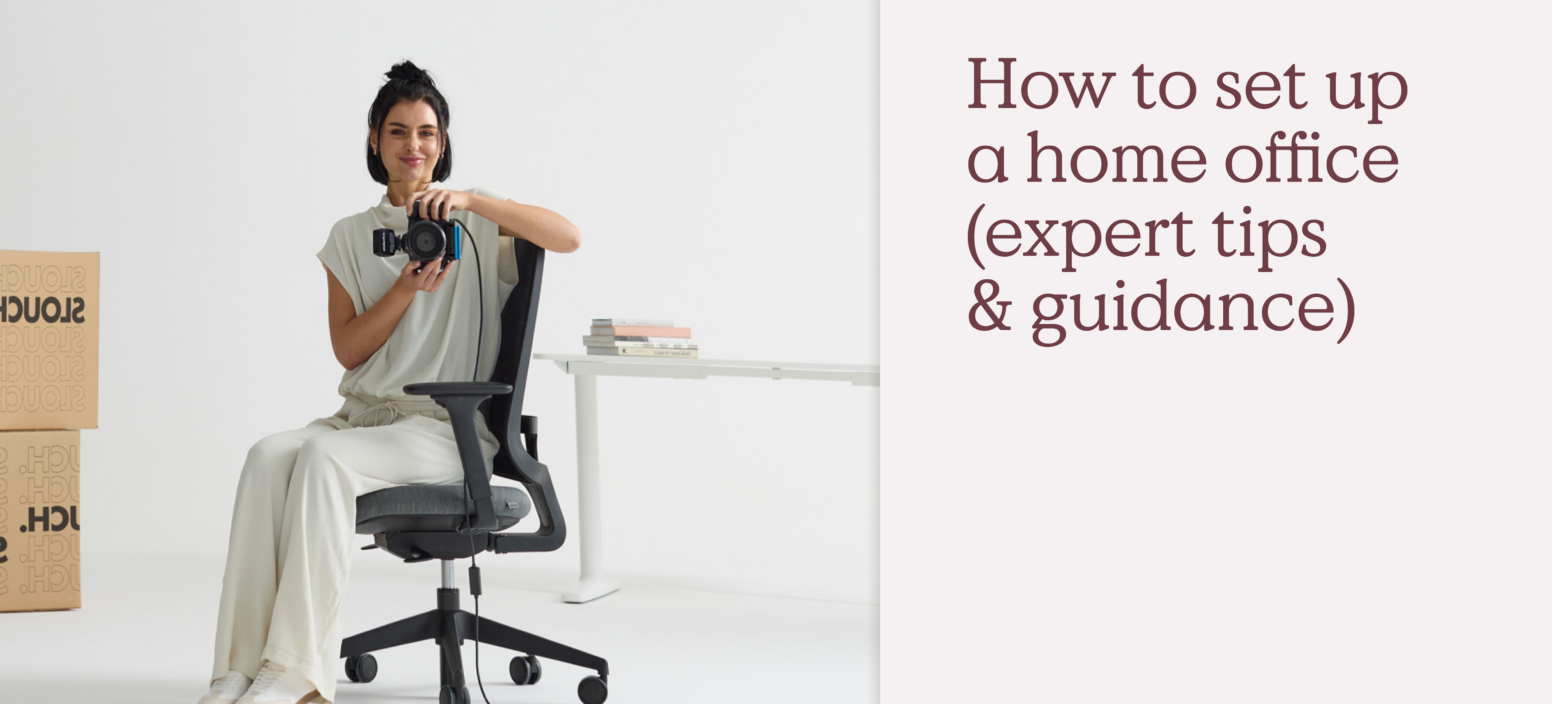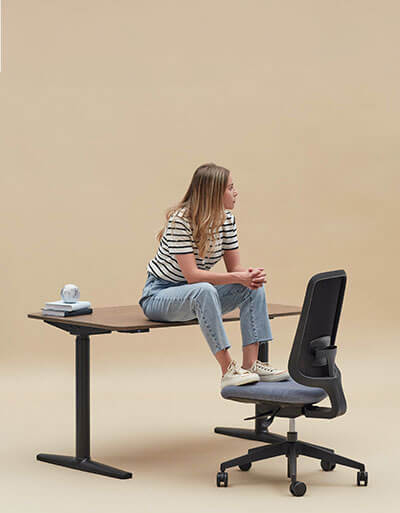Creating your own WFH space and want to know how to set up a home office? You’re in the right place. We don’t just create fantastic ergonomic desks here at Slouch – our experts also dispense their wisdom in handy guides and resources on everything and anything office-related.
Today we’ll be taking you through all of the helpful guidance, hints and tricks we’ve got up our sleeves to make your new home office a productive haven.
After all, working from home can be a wonderful blessing (hello no commute!) but that can quickly turn into a nightmare if your environment is working against your focus or physical comfort. Luckily, there are plenty of factors within your control that can help make WFH a blessing, not a curse.
Sound useful? Let’s dive straight in.
Finding the right space to WFH
First off, here’s where to consider basing yourself if you want to work from home.
If you possibly can, we’d recommend dedicating a specific room to your work. This means you can control the conditions to be tailored to what you need in order to focus.
It’s also important for creating that all-important mental separation from home and work. If you don’t have a defined workspace the two can easily bleed together, with your home-life boundaries getting eroded by work.
However, we know that most modern homes weren’t set up to have a dedicated office in them, meaning a spare room just for work is a luxury. Never fear – we’ve got some creative options to consider that you might not have thought of yet:
- Combined spare room & office space – Guest rooms are notoriously underused spaces that take up large square footage in our homes. Make them work double duty as an office space to get more from them.
- Box room – If you have a box room that you don’t use, this is prime territory for an office space. After all, as long as you can comfortably fit a desk, office chair and any necessary storage in the room – that’s all you really need.
- Conservatory – If you don’t have a spare room but you do have an unlobed and underused conservatory, you’re in luck. We’ve got a fantastic guide on creating your dream conservatory office in a few simple steps!
- Attic – Attic rooms work surprisingly well as home offices as the often sloped roofs work best in a room where you’ll mainly be sitting down. It also means you can retain any eaves space for home storage.
- Cellar or basement space – Don’t write off an office without windows. With the right tips and tricks even an underground space can become a homely WFH spot.
- Garden room – If you have enough room in your garden, a garden cabin office can provide instant extra space and a peaceful sanctuary for working. You’ll also have the benefit of being physically separated from your home office space.
- Office nook – Even a cubby or cupboard can become a distraction-free spot to work from with a bit of DIY!
Setting up your ergonomic work equipment
No matter where you set up shop for your home office, getting the ergonomic basics right is fundamental. Here’s what to know.
Ergonomic office chair – Not all chairs are created equal. Look for one with adjustable height, good lumbar support and armrests that let your forearms rest comfortably. The more adjustability, the better the chair can conform to your body – in particular your lower back.
Slouch’s ergonomic home office chairs are designed specifically to keep you comfortable and supported all day long.
Adjust your monitor position – The top of your screen should be at or just below eye level, with the screen about an arm’s length away. If you’re using a laptop, get yourself a laptop stand to raise it up (and pair it with a separate keyboard).
Make sure your desk is the right height – When sitting, your arms should form roughly a 90-degree angle with your desk surface. Too high or too low and you’ll be putting strain on your shoulders and wrists that can add up aches and pains. You also need to be able to comfortably rest your feet on the floor.
Keyboard and mouse set up – Position these close enough to avoid reaching. Your wrists should remain in a neutral position, not bent upward or downward. Consider an ergonomic keyboard and mouse if you spend long hours typing.
Proper lighting – Position your desk to make the most of natural light without creating annoying screen glare.Supplement with desk lamps or overhead lighting to reduce eye strain.
Keep moving – Even the perfect work from home set up won’t help if you stay frozen in position all day. Remember to take regular movement breaks – your body isn’t designed to be static for hours on end.
Remember, good workplace ergonomics in the workplace is all about supporting your body so that you aren’t put in unnatural positions that leave you with pain.
10 tips to set up your home office
If you’re wondering how to set up a home office there’s a lot you might not have considered. Let us help you set it up right the first time with our handy tips and tricks. That way you won’t have to make loads of changes to get it right.
1. Sort your tech set up
Before you try working in your new home office for real, ensure you have reliable WiFi.
Test your connection in different spots before settling on your workspace location and consider a wired ethernet connection for important video calls or large file transfers. There’s nothing more annoying than video calls that freeze or your files glitch while you’re trying to edit them.
2. Gather your home office essentials
Stock up on the WFH essentials that will boost your daily productivity. For instance, a good quality USB hard drive for backups, a WiFi extender if you’re working far from your router, multi-monitor set ups and ergonomic accessories like wrist pads to prevent strain. These are just some of our top suggestions, tailor it to your own requirements.
3. Personalise your workspace with thoughtful decor
Your home office set up shouldn’t just be functional, it needs to make you feel happy. Add personal touches like framed photos, artwork that energises you or even a small vision board to keep your goals front and centre.
Plants are brilliant mood-boosters (even low-maintenance varieties like succulents or snake plants) and a stylish desk lamp can add both practical light and aesthetic appeal. You could also add a small mirror to make the space feel larger and brighter.
Remember, you’ll be spending hours here daily – make it a space you genuinely enjoy with some wall and desk decorations.
4. Create transition rituals
Without a commute, it can be hard to switch between “home mode” and “work mode.” Develop small rituals that signal the start and end of your workday – perhaps brewing a special morning coffee or taking an evening walk around the block.
If you still can’t stop thinking about work, we’ve got some extra tips on how to switch off at the end of the working day.
5. Set a designated space for documents
We’d recommend going paperless where possible but sometimes physical documents are unavoidable. Creates a system to take care of them. A simple filing cabinet or set of labelled folders can save you from papers piling up on your desk and make tax time infinitely less stressful.
6. Make your space fit for focus
Consider how scent and sound can enhance your productivity. Perhaps a specific essential oil diffuser that you only use during work hours, or a carefully curated playlist that signals to your brain it’s time to focus.
Plus, ensure you have a good set of noise-cancelling headphones to control your auditory environment as well. Working with an especially high level of background noise? Consider investing in a white noise machine.
7. Control your ambient comfort
What do we mean by this? Essentially, this means keeping your environment comfortable. For example, you can’t do your best work if you’re constantly chilly. This can be a big problem in conservatory offices.
In the UK’s colder climate, a small portable heater can make winter mornings in a home office bearable. A decent fan is also essential for those few weeks of summer heat. Consider a smart thermostat if you can, so that you can schedule your heating to come on before you start work.
Proper air circulation is also crucial, with decreases in air quality directly affecting cognitive abilities! In other words, more carbon dioxide throughout the day means you might lose your focus.
Position your desk where you can crack a window occasionally for fresh air. A small humidifier can also help in winter when central heating dries out the air, meaning fewer headaches and dry eyes.
8. Invest in organisation solutions
Even in small spaces, clever storage can make all the difference. Think vertically with floating shelves or pegboards that transform blank walls into functional storage. For your desk area, consider under-desk drawers, monitor stands with built-in compartments or even slim rolling storage carts that tuck away when not needed.
Remember: less clutter means a distraction-free environment, so make sure everything has a home and messy wires are tucked away.
9. Create a professional-looking background
One problem with having your home office in your real-life home – sometimes things look less professional than you’d like.
We get it, you might need to put some laundry on an airer in your office or stack some parcels waiting to be sent if you’re in a multi-purpose room. However, make sure you have a clean, tidy and professional backdrop ready for calls.
If this is a big issue, look into creating a virtual one – just make sure it’s realistic and not a distraction itself.
10. Have clear boundaries with your household
Another common issue when setting up a home office? Family members or housemates popping in and out, disrupting your workflow and potentially important meetings.
This is easily solved with a frank conversation about expectations. A ‘do not disturb’ sign or signal can give you extra peace of mind that you won’t be burst in on during important or sensitive meetings.
Make anywhere work-friendly with an ergonomic chair
Feeling ready to create your perfect home office set up? Start with the foundation of any productive workspace – a proper ergonomic chair and desk that support your body throughout the day.
At Slouch, our range of ergonomic work chairs and height-adjustable desks are designed to give you seating and workstations that are as customised to your body as possible. With adjustable height, seat position, armrest position and lumbar support, it doesn’t get more bespoke than this.
So, for a chair that’s engineered to fully support you while also looking beautiful and sitting proudly in your home, think Slouch.
Browse our collection today and take the first step towards total WFH comfort.
Additional reading:

